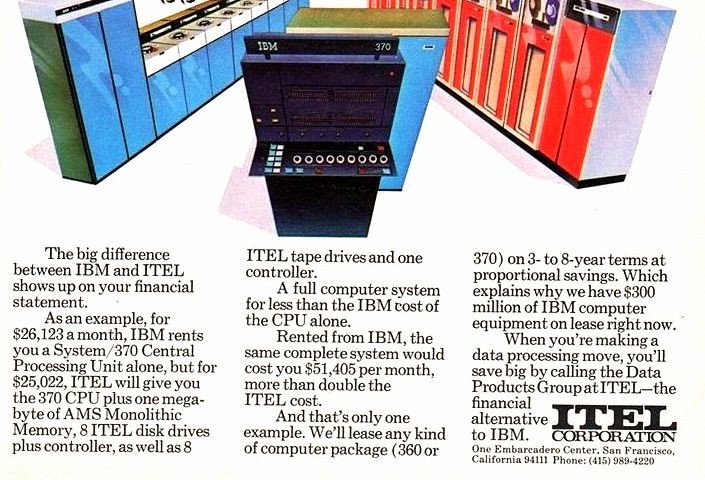Preamble
The Australian Computer Society (ACS) was formed 50 years ago, when the various state computer societies joined forces.
To mark the occasion, the ACS has initiated a heritage project to honour the many individuals who have contributed to the growth of the ICT profession in Australia.
At the heart of the project is a history of computing in Australia. It is not just a history of the ACS, but the history of a profession.
Australia has the longest computing history of any country, excepting the US and the UK, and CSIRAC in the Museum of Victoria is the oldest computer still in existence.
Chapter 30: The rise and decline of the PCMs
After Amdahl (see Chapter 29), the most successful IBM mainframe plug-compatible manufacturer (PCM) was Hitachi Data Systems (HDS). HDS had its origins in Itel, a US computer leasing company that decided in 1976 to make IBM-compatible mainframes.
It contracted the work to a company called National Advanced Systems (NAS), a joint venture between US chip company National Semiconductor (NatSemi) and Japanese conglomerate Hitachi. But NatSemi had serious financial problems. Its business began to go bad in the mid-1980s and it began to rely heavily on NAS, which remained profitable, to prop it up.
Hitachi and NAS had many legal problems in the early 1980s. In 1982, Hitachi was charged with stealing IBM trade secrets, including information about IBM's mainframe architecture. That dispute was resolved, with an agreement that IBM would share technical information about its MVS/XA operating system for a fee. Hitachi also agreed to share its secrets with IBM. The deal was similar to the IBM Fujitsu arbitration (see Chapter 28).
NatSemi sold out in May 1988, when NAS was acquired by Hitachi (80 per cent) and Electronic Data Systems (EDS) for US$398 million and renamed HDS. Hitachi is one of the three giants (with Fujitsu and NEC) of the Japanese computer industry. EDS was a large software and services company founded by the legendary Ross Perot in 1962, and acquired by General Motors in 1984, and then HP in 2008.
EDS took a largely hands-off role in HDS. It supplied some management expertise, but it did not favour the company in its many systems integration bids. At that time Hitachi was a leading supplier of IBM-compatible disk and tape drives. The technical excellence of these products allowed it to compete strongly against IBM throughout the 1980s, and enable HDS to win substantial mainframe business.
The company entered the Australian market in 1977 when Australian leasing company Datronics started distributing Itel products in Australia. But before Datronics had sold any machines, Itel decided to set up a subsidiary, which began operations in Melbourne at the beginning of 1978. General manager was Curtis Reid.
In 1979 Reid was replaced by Bruce Eggington, formerly the marketing director. At the end of that year, Australian operations were transferred the local subsidiary of NatSemi, and renamed NatSemi Advanced Systems. It operated under that name until the formation of HDS Australia in 1988.
HDS supplied a wider range of machines than did Amdahl, closely mirroring IBM's entire range. Unlike Amdahl, it did not have a history being a ‘value-added PCM’, being content to offer total compatibility with IBM. That was both a weakness and a strength, and meant that HDS had to compete on price alone.
HDS was also very successful with its range of mainframe disk drives, and built up a strong reputation for reliability and price-performance. Much of its mainframe business came from accounts which first installed only its peripherals, enabling it to establish a relationship with the user which eventually translated into a system sale.
Against the might of IBM
Many other PCMs tried and failed, though some had short-term success. The release of the System/360 in 1964 saw the emergence of many suppliers who became quite successful selling tape and disk drives for the range. The System/360's consistent architecture, which ensured that the same peripherals could be used on all machines, was designed to make things easy for IBM and its customers, but it also made things easy for an emerging band of PCMs.
Many of these suppliers were quite successful for a while. IBM viewed their emergence with horror and undisguised disdain, and began a FUD (Fear, Uncertainty and Doubt) campaign against them, attempting to convince customers that the PCM's devices were less reliable than IBM's, or that they would lead to increased maintenance charges, or that they might not be compatible with later releases of IBM's processors or software.
The problem, from IBM's viewpoint, became more severe when some of these upstart PCMs began to make processors that were compatible with the IBM mainframe range. Over the years, most of these manufacturers withered and died, but many of them enjoyed enough success in the short term to have IBM very worried indeed.
They included names that have since disappeared, like Cambridge Memories, IPL, Magnusson (which hired Gene Amdahl's son Carl) and Two Pi. Two Pi, backed by Dutch giant Philips, released a PCM machine called the V32 to compete against IBM’s low-end 4300 in 1979. These machines were briefly distributed in Australia by Sydney-based Semiconductor Systems.
But Two Pi died like all the others. These suppliers had no great difficulty in copying the early IBM S/360s, but IBM made it more and more difficult for them as newer models were released.
A notable PCM failure was Storage Technology (StorageTek), which was for many years one of the more successful of the plug-compatible peripheral suppliers. StorageTek's attempt to make its own processor and become another Amdahl or HDS almost drove it out of business.
It took years to recover, doing so largely because of the remarkable success of its ACS 4400 robot tape library for IBM mainframes, and vowed to never again get involved in the processor market.
Trilogy Systems
The most spectacular of all the failed PCMs was Trilogy Systems, an ambitious attempt to build an IBM-compatible mainframe from the ground up. Trilogy was headed by Gene Amdahl, and attracted over $300 million from private investors and a 1983 public stock offering.
Trilogy gambled on an untried technology that would have seen massive 4 inch square chips, each containing around 40,000 high speed circuit gates, with 100 such wafers layered together into giant modules. Major vendors, including DEC, Unisys, and Bull, purchased rights to the technology.
The gamble failed. Trilogy tried to break new technological ground on too many fronts at once. It was far too ambitious. The size of the engineering task became too large, and impossible to control in a new organisation. In one of the best publicised and most expensive failures in computing history, Trilogy went broke, losing its investors hundreds of millions of dollars, in 1986.
Decline of mainframes
By the 1990s, the mainframe market was in decline, but HDS and Fujitsu stayed in the game until 2000 when they both decided not to compete against IBM anymore. That marked the end of the PCM era, in Australia and globally.
IBM’s System/360 had evolved into the System/370 and then, in 1990, to the System/390. In 2000, IBM revamped its entire mainframe range, renaming it the zSeries, and then later the System z. The Z was meant to stand for ‘zero downtime’.
The new machines were still compatible with IBM’s earlier mainframes, but they used a new 64-bit instruction set and IBM-designed CISC (complex instruction set computing) microprocessors that were very cost-effective and which were difficult to copy.
The cost of competing technologically in a declining market lead to Fujitsu (which by this time had absorbed Amdahl) and HDS to withdraw from the mainframe market, leaving IBM as the sole supplier.
That meant the PCM era ran from 1964, when IBM’s System/360 was released, to 2000, when its competitors exited the market. It was a very important era in the history of computing, and significant in terms of the Australian industry.
Most of Australia’s large government departments and agencies, all of its major banks and financial institutions, and most large commercial organisations ran their businesses on IBM or PCM mainframes.
Veteran ICT journalist Graeme Philipson is researching and writing the Heritage Project book, which is due for release on the 50th anniversary of the formal incorporation of the ACS, on 3 October 2017.
The project also involves the creation of a ‘virtual museum’, cataloguing hardware and other artefacts, and collecting and curating documents on the history of the industry, including oral histories of as many people as possible.
Please get in touch with Graeme if you would like to contribute, at [email protected]
Do you have early memories of the ICT industry in Australia? Help us make history by sending us your story! Record or write your memories to be included in our historic ACS Heritage Project. Details here.
Previously published:
Chapter 29: ‘Plug compatible manufacturers’ take on IBM
Chapter 28: The rise of Fujitsu
Chapter 26: The rest of the BUNCH
Chapter 25: Honeywell in Australia
Chapter 23: ACS at home and abroad
Chapter 22: The early years of the Australian Computer Society
Chapter 21: Other Australian universities
Chapter 20: University of Melbourne and Monash
Chapter 19: Sydney University and UNSW lead the way
Chapter 18: Computing in the Australian Government
Chapter 17: Trevor Pearcey and the birth of CSIRONET
Chapter 16: Enter the minicomputer – DEC comes to Australia
Chapter 15: The IBM S/360 in Australia
Chapter 14: IBM redefines the computer industry
Chapter 13: Control Data Australia (part II)
Chapter 12: Control Data Australia (part I)
Chapter 11: The Australian Computer Society
Chapter 10: Five Computer Societies
Chapter 9: Australian made, Australian designed
Chapter 8: Australia's Computer Industry in 1962
Chapter 5: SILLIAC and the Snowy Mountains Scheme
Chapter 3: Harry Messel and the birth of SILLIAC










